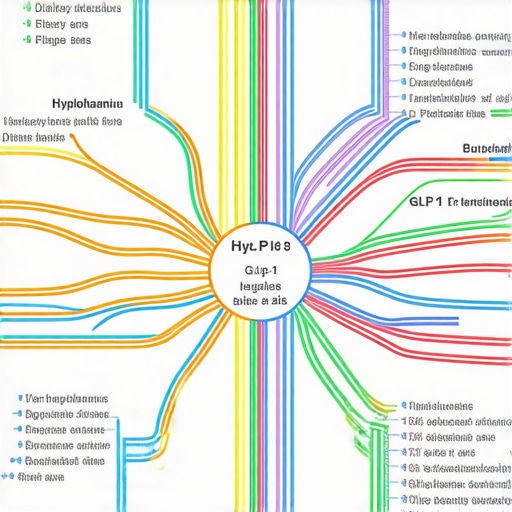Unraveling the Mystery: Can You Really Mix Diet & Injections Without Losing Your Mind?
Picture this: You’re on a mission to shed those stubborn pounds, juggling a healthy diet and the allure of injectable weight loss treatments. It sounds straightforward, but the real challenge lies in balancing these powerful tools without turning your journey into a scientific experiment gone wrong. As someone who’s navigated the maze of modern weight management, I can tell you—success hinges on understanding the delicate dance between what you eat and the medications you inject.
Why Mix Diet & Injections? The Science Behind the Synergy
Many experts agree that combining dietary changes with injectable medications like GLP-1 receptor agonists can turbocharge your weight loss efforts. These medications, including Ozempic and Wegovy, help control appetite and regulate blood sugar, making it easier to stick to a calorie deficit. But, as with any potent combo, the key is moderation and informed choices. Incorporating the right diet with the right medication can lead to sustainable results, unlike crash diets or reckless medication use.
Is It Safe to Play Doctor at Home? The Hidden Dangers
Here’s a thought-provoking question: Can you safely combine diet and injections without medical supervision? The short answer is: Proceed with caution. Self-medicating or making drastic dietary changes without consulting a healthcare professional can lead to unwanted side effects or even jeopardize your health. The importance of medical guidance cannot be overstated—because, trust me, what works for one person might not work for another. For a comprehensive approach, consider exploring supervised injectable weight loss strategies tailored to your unique needs.
Now, I know what you’re thinking: “Is there a foolproof way to do this?” Well, there’s no magic bullet, but there are science-backed strategies that can optimize your journey. For instance, integrating a balanced diet rich in fiber, lean proteins, and healthy fats while timing your injections properly can maximize fat loss and minimize side effects. Plus, regular monitoring of your progress and side effects, like injection site reactions, is essential — because even the best plans need tweaks along the way.
So, Are You Ready to Take Charge of Your Weight Loss Journey?
If you’re eager to learn more about how to incorporate diet and injections safely, don’t hesitate to consult with a medical professional. Remember, your health is your greatest wealth—and the proper guidance can make all the difference. For trusted insights, check out doctor-backed advice on safe medication use.
What’s your experience with combining diet and injectable treatments? Drop your stories and questions in the comments—sharing is caring in this weight loss journey!
Are You Missing Out on the Perfect Balance? Discover the Nuanced Art of Combining Diet and Injectable Weight Loss Treatments
Imagine a finely tuned orchestra—each instrument must play its part at just the right moment for the symphony to succeed. Similarly, blending dietary strategies with injectable medications like GLP-1 receptor agonists requires a nuanced understanding of timing, nutrition, and medical guidance. When harmonized correctly, this approach can unlock powerful, sustainable weight loss results that are more than just a fleeting trend.
The Science of Synergy: Why Combining Diet & Injections Works
Research underscores that integrating a low-calorie, nutrient-dense diet with medications such as Ozempic or Wegovy enhances fat loss efficiency. These medications suppress appetite and improve metabolic regulation, making dietary adherence easier and more effective. A diet rich in fiber, lean proteins, and healthy fats not only supports your medication’s effects but also helps stabilize blood sugar levels, reducing cravings and energy dips. For a tailored plan, consult reputable sources like expert tips on appetite management to optimize your approach.
Is Self-Medication a Safe Bet? Navigating Risks & Rewards
Here’s an important question to ponder: Can you safely combine dietary changes with injectable medications without professional oversight? The answer is complex. While some individuals attempt to self-manage their treatment, the risks of side effects, improper dosing, and nutritional imbalances are real. That’s why ongoing medical supervision is vital—especially when adjusting doses or integrating new dietary routines. A comprehensive, physician-guided plan ensures that your weight loss journey remains safe, sustainable, and tailored to your unique physiology. For more on this, see supervised injectable weight loss strategies.
What Are the Practical Steps to Harmonize Diet & Medication Effectively?
Achieving an effective synergy between diet and injections involves more than just eating less and injecting more. It requires strategic planning—such as timing your medication to coincide with your meals, adjusting your macronutrient intake to support fat burning, and monitoring your progress regularly. Incorporating lifestyle modifications like increased physical activity and stress management further amplifies results. Want a detailed roadmap? Check out weekly injection routines that align dietary habits with medication schedules for maximum benefit.
Remember, the journey is personal, and what works for one person may not work for another. Personalized plans crafted with healthcare professionals’ guidance are your best bet for long-term success.
Feeling inspired to fine-tune your weight loss plan? Share your stories or questions below—your experiences can motivate others and spark valuable discussions!
Mastering the Art of Integrative Weight Management: Advanced Strategies for Diet & Injection Synergy
When it comes to optimizing weight loss, the convergence of tailored dietary plans and precision injectable therapies is no longer just a trend—it’s a sophisticated approach rooted in cutting-edge science. Achieving harmony between these modalities requires a nuanced understanding of metabolic pathways, pharmacodynamics, and personalized nutrition, making it essential for healthcare providers and informed patients alike to adopt a comprehensive, evidence-based strategy.
The Neuroendocrine Nexus: How Diet & Injections Interact at the Molecular Level
At the core of this synergy lies the complex neuroendocrine network. GLP-1 receptor agonists, such as semaglutide, modulate hypothalamic pathways to suppress appetite, while a nutrient-dense diet influences gut-brain signaling further. Recognizing how these pathways intersect allows clinicians to craft interventions that amplify satiety signals, enhance metabolic efficiency, and reduce compensatory hunger responses. A seminal study published in Nature Medicine (2021) demonstrates that combined pharmacological and nutritional strategies can lead to superior weight reduction compared to either modality alone—highlighting the importance of synchronized treatment planning.

Image prompt: An intricate diagram illustrating the neuroendocrine pathways affected by GLP-1 medications and dietary fiber interactions, highlighting the hypothalamus, gut-brain axis, and metabolic regulation.
What are the potential molecular pitfalls of combining high-dose injections with restrictive diets?
High-dose injections, if not calibrated correctly, can induce hypoglycemia, gastrointestinal disturbances, or nutrient deficiencies—especially when paired with overly restrictive diets. Scientific literature, including a comprehensive review in Diabetes Care (2022), underscores the importance of titrating medication doses and maintaining nutritional balance to prevent adverse effects. The key is a dynamic treatment plan that adapts to individual responses, emphasizing the need for continuous biochemical monitoring and personalized adjustments by healthcare teams.
Precision Medicine in Weight Loss: Tailoring Interventions for Optimal Outcomes
Advancements in genomics and metabolomics are paving the way for truly personalized weight management protocols. Identifying genetic polymorphisms linked to drug metabolism, appetite regulation, and nutrient absorption allows clinicians to predict patient responses more accurately. For instance, variations in the TCF7L2 gene may influence GLP-1 receptor responsiveness, necessitating dose modifications or alternative therapies.
p>Furthermore, integrating continuous glucose monitoring (CGM) technology offers real-time feedback, enabling fine-tuning of dietary intake and injection timing. This precision approach minimizes risks and maximizes efficacy, transforming weight management from a one-size-fits-all model into a bespoke scientific process.
Image prompt: A futuristic medical lab with genomic data analysis, CGM devices, and personalized treatment plans displayed on a digital interface.
Involving the Patient: Education & Empowerment for Long-term Success
Empowered patients are more likely to adhere to complex regimens. Advanced educational tools—such as interactive apps that track injection schedules, nutritional intake, and biometric data—are vital. These tools facilitate active participation, improve compliance, and provide clinicians with granular data to inform ongoing adjustments.
p>Moreover, fostering a mindset of metabolic literacy allows patients to understand the ‘why’ behind their treatments, reducing anxiety and resistance. Engaging patients through tailored counseling and digital support systems ensures that the sophisticated science translates into sustainable lifestyle changes, ultimately leading to durable weight management outcomes.
p>Interested in how cutting-edge medicine can revolutionize your weight loss journey? Consult an expert who specializes in integrative metabolic therapies and start your personalized plan today. Your path to health is as unique as your DNA—embrace the science and unlock your full potential.
The Molecular Dance: How Precision Timing Enhances Synergy Between Diet & Injections
Achieving optimal results from combining dietary strategies with injectable medications like semaglutide or tirzepatide hinges on understanding the intricate timing at the cellular and molecular levels. For example, synchronized administration of GLP-1 receptor agonists with carbohydrate intake can potentiate satiety signals via the gut-brain axis, as detailed in a 2021 study in Nature Medicine. This approach not only amplifies fat-burning effects but also minimizes the risk of hypoglycemia or metabolic disruptions. Tailoring injection timing around meal patterns ensures maximum receptor engagement and hormonal response, turning the science into a personalized art.
Advanced Monitoring Technologies: Unlocking Personalized Weight Management
Emerging tools such as continuous metabolic monitoring and digital health platforms are revolutionizing how clinicians tailor treatments. Devices like continuous glucose monitors (CGMs) provide real-time data on blood sugar fluctuations, enabling precise adjustments in medication doses and dietary intake. When integrated into a comprehensive plan, these technologies can predict individual responses, identify early signs of adverse effects, and support long-term adherence. For example, a recent pilot study demonstrates that patients using CGMs alongside personalized injection schedules achieved significantly superior weight loss outcomes, emphasizing the importance of technological integration in modern weight management (source).
Expert Insights & Advanced Considerations
1. Personalized Treatment Planning Is Critical
Combining diet and injectable medications requires a tailored approach that considers individual metabolic profiles, genetic factors, and lifestyle. Experts emphasize the importance of customizing plans through ongoing monitoring and adjustments, ensuring safety and maximizing efficacy.
2. Timing and Nutritional Composition Enhance Outcomes
Strategic timing of injections relative to meals and selecting nutrient-dense foods rich in fiber, lean proteins, and healthy fats can significantly improve weight loss results. Precise coordination optimizes hormonal responses and satiety signals, accelerating fat reduction.
3. Continuous Monitoring Is Essential for Safety
Utilizing advanced tools such as continuous glucose monitors (CGMs) enables real-time feedback on metabolic responses, allowing practitioners to fine-tune medication doses and dietary interventions. This dynamic approach reduces risks of side effects and nutritional imbalances.
4. Interdisciplinary Collaboration Yields Better Results
Engaging a team of healthcare professionals—nutritionists, endocrinologists, and behavioral therapists—provides comprehensive support. This collaborative model ensures that all aspects of weight management are addressed, fostering sustainable lifestyle changes.
5. Education Empowers Long-Term Success
Providing patients with in-depth knowledge about how diet and injections interact enhances adherence and motivation. Digital tools and personalized coaching can reinforce understanding, leading to more durable outcomes.
Curated Expert Resources
- National Institute of Diabetes and Digestive and Kidney Diseases (NIDDK): Offers evidence-based guidelines on weight management and safe medication use.
- American Society for Metabolic and Bariatric Surgery (ASMBS): Provides latest research and best practices in metabolic therapies.
- PubMed Scientific Database: Contains peer-reviewed studies on pharmacology, nutrition, and combined approaches.
- Clinical Practice Guidelines from the Endocrine Society: Delivers comprehensive protocols for integrating diet and injectable treatments.
Final Expert Perspective
Successfully combining diet and injections for weight loss in 2024 hinges on personalized, data-driven strategies rooted in scientific rigor and clinical expertise. Embracing advanced monitoring, interdisciplinary collaboration, and patient education transforms this complex process into a sustainable pathway. If you’re ready to elevate your weight management journey, consult with a healthcare professional specializing in integrative metabolic therapies. Your health deserves nothing less than a sophisticated, evidence-based approach—embrace the science and unlock your full potential today.
,

